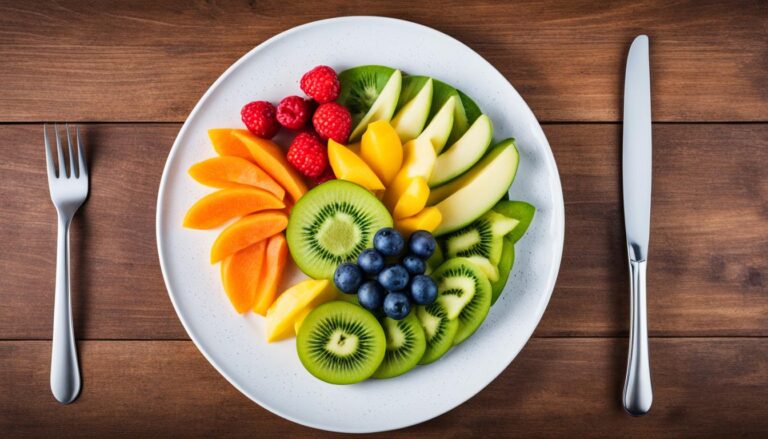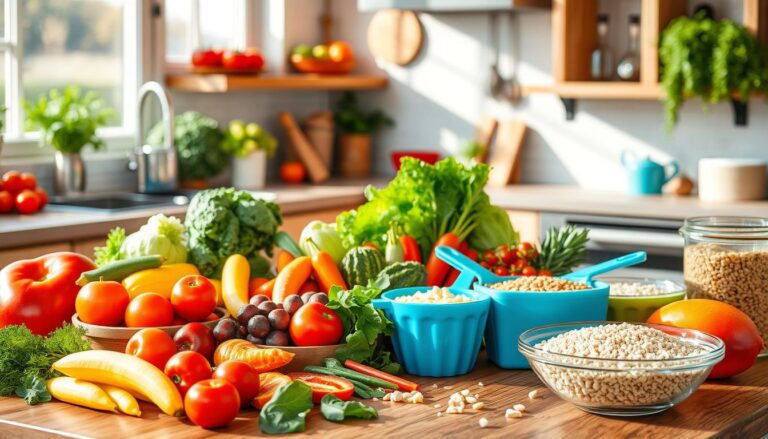Do you know that 90% of adults don’t eat enough veggies? If that’s you, you might be missing out on important nutrients and health perks.
Vegetables are full of vitamins, minerals, fiber, and antioxidants. They’re key to a balanced diet. Here are 7 strong reasons to eat more veggies.
Key Takeaways
- Vegetables are essential for overall health and well-being
- They provide a wide range of vital nutrients, including fiber, vitamins, and antioxidants
- Incorporating more vegetables into your diet can help reduce the risk of chronic diseases
- Exploring new preparation methods and flavor combinations can make vegetables more appealing
- Increasing vegetable consumption is a simple yet impactful step towards a healthier lifestyle
The Importance of Vegetables in a Balanced Diet
Vegetables are key to a healthy diet. They are packed with vitamins, minerals, fiber, and antioxidants. These nutrients help keep you healthy and feeling good.
They support your digestive health, boost your immune system, and help you recover from exercise. Adding more veggies to your meals is a smart move for your health.
Essential Nutrients and Health Benefits of Veggies
Fiber in vegetables helps with digestion and makes you feel full preventing overeating. Antioxidants in veggies are crucial for a strong immune system. They also fight chronic inflammation, which can lead to health problems.
There are many ways to prepare vegetables, from fresh to canned. This makes cooking with them fun and easy. Eating veggies regularly means you get to enjoy tasty healthy meals that boost your health.
Vegetables are the foundation of a healthy, balanced diet. Incorporating more of these nutrient-dense foods can have a profound impact on your physical and mental health. Nutritionist, Jane Doe
Adding veggies to your diet supports your immune system, helps with recovery from exercise, and gives you the fiber intake and nutrient dense foods you need. Eating veggies often is a great way to live healthier and feel better.
Consequences of Not Eating Enough Vegetables
Not eating enough vegetables can harm your health in many ways. It can lead to nutrient shortages, increase the risk of chronic diseases, and cause digestive problems. Eating more vegetables is key to staying healthy and balanced.
Research shows that 90% of people don’t get enough fruits and vegetables daily. Men should eat a bit more vegetables than women. Adults need 2 cups of fruit and 2.5 to 3 cups of vegetables every day. Vegetables are also a great source of fiber, which is important for health.
Not eating enough fruits and vegetables can make you feel tired and cause muscle cramps. These foods are full of water, which helps you stay hydrated. They also have antioxidants that can make your skin look better reducing acne and wrinkles.
Vegetables are packed with vitamins and minerals like Vitamins A, C, and K. These are important for your eyes immune system, and brain. Not getting enough of these nutrients can harm your health, including your hair and nails.
Studies link not eating enough fruits and vegetables to a higher risk of depression. On the other hand, eating more of these foods can lower the risk of heart disease, diabetes, Alzheimer’s, cancer, and other chronic illnesses. In fact, eating just one more serving of vegetables and fruits per day is linked to a 4% lower risk of dying from heart disease.
Clearly, not eating enough vegetables has big health risks. Adding more of these foods to your diet is a simple way to boost your health and well being.

Recommended Vegetable Servings and Portion Sizes
Experts say you should eat at least five servings of fruits and vegetables daily. Aim for three servings of vegetables and two servings of fruits. But most people don’t hit this mark. For those who exercise a lot, you might need more. They suggest five to nine servings a day to help with energy, muscle work, and recovery.
A serving of vegetables is usually a cup of raw greens, half a cup of fresh or canned veggies, or half a cup of vegetable juice. To get enough daily vegetable intake, knowing the right serving sizes is key.
Adjusting Intake for Active Individuals
If you’re very active, you’ll need more nutrients to keep up with your body’s needs. Experts recommend five to nine servings of fruits and vegetables a day for active folks. This helps meet your higher nutrient needs.
| Audience | Recommended Fruit and Vegetable Servings Per Day |
|---|---|
| General Population | 5 servings 3 vegetables, 2 fruits |
| Active Individuals | 5-9 servings |
Adding a mix of colorful veggies to your meals helps you meet your daily vegetable intake. It also boosts your health and wellness.
Clever Ways to Incorporate More Veggies
Adding more vegetables to your daily meals can be fun and healthy. It’s all about finding ways to prepare veggies that you like. A simple way to eat more veggies is by adding greens like spinach or kale to your favorite fruit smoothies. This way, you get a drink full of nutrients without changing the taste much.
Finding Vegetables You Enjoy
Try different vegetables to see which ones you like best. Some people like raw veggies, while others prefer them cooked. Try various cooking methods and seasonings to find what you enjoy. This makes adding more veggies to your meals fun.
Blending Greens into Smoothies
Smoothies are great for adding veggies to your diet. By mixing greens like spinach or kale with fruits, you get a tasty drink packed with nutrients. This is perfect for those who don’t like the taste of some greens. The fruit’s sweetness can hide the earthy flavor, making veggies easy to drink.
| Veggie Preparation Tip | Benefits |
|---|---|
| Cauliflower rice or finely chopped veggies in pasta and rice dishes | Increase vegetable intake without drastically changing the flavor of familiar dishes |
| Lettuce wraps and veggie buns | Reduce calorie intake by using low-calorie lettuce instead of higher calorie buns |
| Veggie noodles made from zucchini, carrots, or spaghetti squash | Lower-carb and higher-nutrient alternatives to traditional pasta |
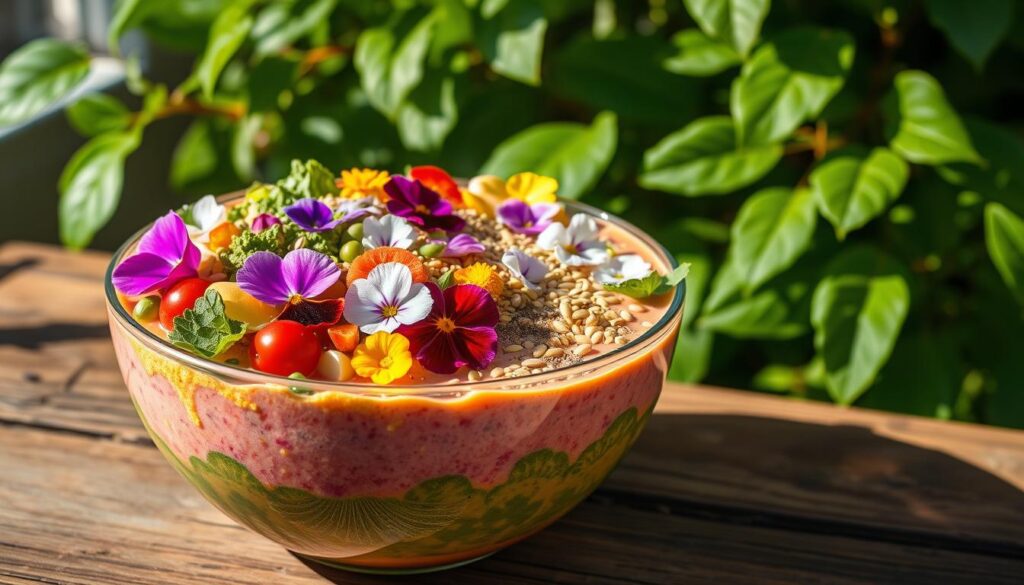
By trying new ways to add veggies to your meals and snacks, you can get lots of nutritional benefits. From making smoothies with greens to finding your favorite ways to prepare veggies, there are many ways to make your diet better with these important foods.
The Versatility of Frozen Vegetables
Frozen vegetables can change the game when you want to eat more veggies. They are as nutritious as fresh ones, sometimes even more so. They are also easy on the wallet and don’t go bad quickly, which is great if you can’t use up fresh produce fast.
Freezing veggies helps keep their nutrients. This method locks in vitamins and minerals. For instance, frozen broccoli might have more vitamin C than fresh broccoli.
Frozen veggies are super convenient. They come pre-cut and pre-washed, saving you time in the kitchen. You can easily add them to many dishes, like stir fries, soups, casseroles, and roasted veggie medleys. This makes your meals healthier and quicker to make.
Also, frozen veggies are cheaper than fresh ones, especially when fresh produce is pricey. They last longer, which means less food waste. This makes them a smart choice for your budget.
Frozen vegetables are a game-changer for busy individuals who want to eat healthier without the hassle of prepping fresh produce. Chef Emily Simmons
Next time you want to make your meals better, try frozen veggies. They offer great nutrition, convenience, and value. With many options available all year, frozen veggies are a great addition to your cooking.
Hiding Veggies in Familiar Dishes
As a parent, getting your family to eat enough veggies can be tough. Some kids don’t like the taste or texture of certain vegetables. But, there’s a smart way to add more nutrition to your meals without losing flavor or fun.
It’s called stealth health cooking. You blend, grate, or chop veggies like spinach, carrots, or cauliflower into familiar dishes. This way, you can add them to soups, sauces, casseroles, and even baked goods without changing the taste or look.
A study in America showed this method works well. Kids ate almost twice as many vegetables when their meals had pureed veggies. And they liked these veggie enriched meals just as much as the others.
This approach makes meals healthier and family-friendly at the same time. By hiding veggies in favorite dishes, you make sure your family gets important nutrients without fighting over veggies.
https://www.youtube.com/watch?v=W7K56bHpukw
But don’t just hide veggies. Teach kids to like vegetables, let them help with cooking, and introduce them to many veggies. This helps them develop good eating habits for life.
Next time you want to hide veggies and boost nutrition in family-friendly meals, try stealth health cooking. With creativity and patience, even the pickiest eaters can become veggie fans.
Enhancing Vegetable Flavors
If you’ve found vegetables taste bland, don’t worry. There are many ways to make them more enjoyable. By trying flavor enhancement, dips and sauces, healthy fats, and spices and herbs, you can turn basic veggies into tasty side dishes or snacks.
Unlock Flavor with Dips and Sauces
Adding a delicious dip or sauce can change everything. Think about creamy Greek yogurt dips, tangy hummus, or zesty pesto. These dips not only taste great but also help your body absorb vitamins better.
The Power of Healthy Fats
Using fats like extra virgin olive oil or avocado oil can make veggies taste better. These fats add a rich flavor and help your body get vitamins A, D, E, and K from veggies.
Spice Up Your Veggies
Try different spices and herbs to find what you like. From earthy cumin to zesty chili powder, there are many choices. Adding these seasonings can make veggies taste amazing.
| Vegetable | Flavor-Enhancing Pairing |
|---|---|
| Roasted Brussels Sprouts | Balsamic glaze, Parmesan cheese, and toasted almonds |
| Sautéed Zucchini Noodles | Pesto, sun-dried tomatoes, and pine nuts |
| Grilled Asparagus | Lemon zest, garlic, and Parmesan |
Using these tips, you can make vegetables a key part of your healthy meals. They’ll be delicious and nutritious.
Exploring Different Preparation Methods
Variety makes life interesting, and this is true for cooking vegetables. Trying new ways to prepare veggies can keep meals exciting. From roasting to grilling, there are many ways to make veggies tasty.
Homemade Vegetable Chips and Crisps
Turning veggies into crispy chips or crisps is a fun way to enjoy them. This method lets us have a healthy snack that tastes great. Just slice veggies like kale or sweet potatoes thinly, add some olive oil and seasonings, and bake until crispy.
Homemade chips and crisps are a great choice for a healthy snack. They’re packed with vitamins, minerals, and fiber from the veggies. Plus, they’re easy to make, so adding more vegetables to your diet is simple and tasty.
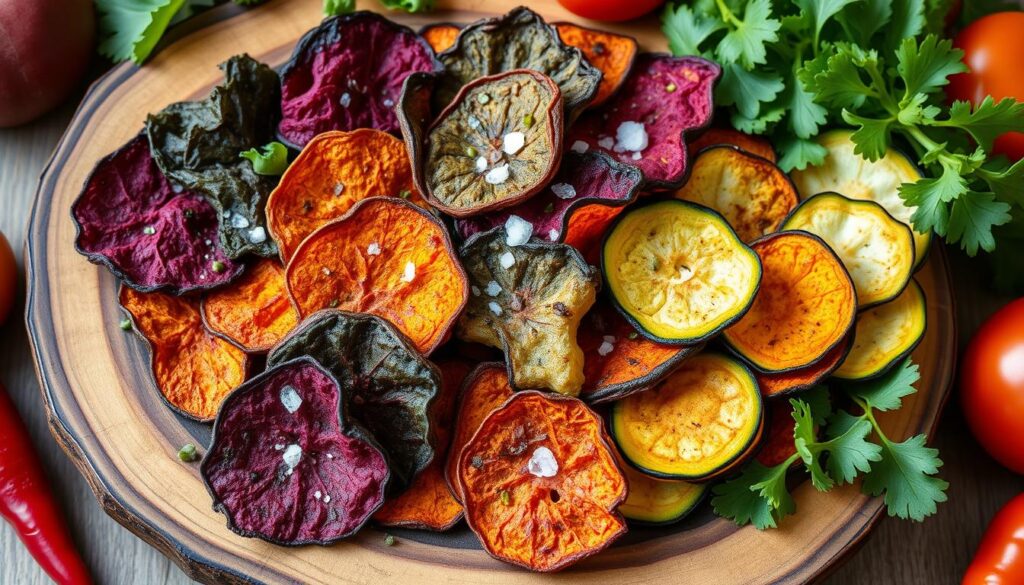
Eating a variety of vegetables is the key to a healthy, balanced diet. Homemade vegetable chips and crisps are a great way to enjoy your favorites in a satisfying, guilt free way.
7 Compelling Reasons to Add Vegetables to Your Plate
Vegetables are key to a balanced diet, offering many health benefits that can change your life. They help improve your health and prevent disease. Here are seven reasons to make veggies a big part of your meals.
- Immune System Support: Leafy greens like spinach, kale, and collard greens are packed with vitamins A, C, and K. They also have folic acid, calcium, iron, and antioxidants. These nutrients may lower the risk of heart disease.
- Reduced Chronic Disease Risk: Studies show that leafy greens can lower the chance of chronic diseases like diabetes.
- Blood Glucose Management: Broccoli is great for managing blood sugar levels. It’s full of vitamin C and K and has soluble fiber. Broccoli also has sulforaphane, which helps with blood glucose.
- Heart Health Support: Red bell peppers are loaded with vitamin C and beta-carotene. They’re good for people with diabetes.
- Anti-Inflammatory Benefits: Tomatoes are full of lycopene. This can help prevent diabetes, obesity, and heart disease.
- Versatility and Nutrient Density: Cauliflower is like broccoli but also has sulforaphane. It’s full of folate and vitamins C and K. You can use it as a carb-friendly swap in many dishes.
- Immune System Boosting: Mushrooms, like Maitake, are rich in vitamin D. This vitamin supports the immune system and bone health.
By finding creative ways to eat more vegetables, you can enjoy their many benefits. Let’s promise to add more veggies to our plates. Let’s embrace the power of plant-based nutrition.
Vegetables are a must on a diet. I suggest carrot cake, zucchini bread, and pumpkin pie. Jim Davis
Types and Serving Sizes of Common Vegetables
The world of vegetables is full of variety, offering many options to nourish us. From leafy greens to vibrant red and orange veggies, each type has its own benefits. They add unique nutrients to our meals.
For raw leafy greens, a 1 cup serving is recommended. Other raw or cooked veggies should be about 1/2 cup. Vegetable juices should also be 1 cup. These sizes can change based on where you live, as they’re not the same everywhere.
| Vegetable Type | Serving Size | Nutrient Content |
|---|---|---|
| Leafy Greens e.g., spinach, kale, arugula | 1 cup raw | High in vitamins A, C, and K, as well as fiber and folate |
| Cruciferous Vegetables e.g., broccoli, cauliflower, Brussels sprouts | 1/2 cup cooked | Rich in antioxidants, fiber, and sulforaphane, which may help reduce cancer risk |
| Root Vegetables e.g., carrots, beets, sweet potatoes | 1/2 cup cooked | High in vitamins A and C, as well as fiber and complex carbohydrates |
| Nightshade Vegetables e.g., tomatoes, bell peppers, eggplant | 1/2 cup raw or cooked | Contain lycopene, vitamin C, and various antioxidants |
| Legumes e.g., beans, lentils, peas | 1/2 cup cooked | High in protein, fiber, and a variety of vitamins and minerals |
Adding different vegetables to your daily meals is a great way to get more nutrients. Knowing the types and how much to eat helps you meet your health goals. This way, you support your health and well-being.
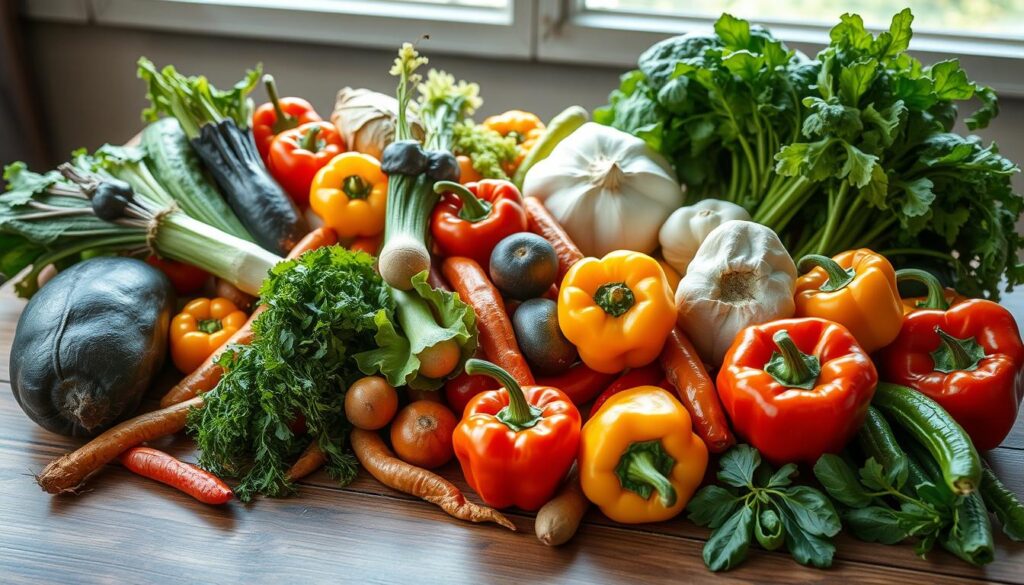
It’s not just how much vegetables you eat, but also the variety. Try to eat a mix of colors and textures. This approach ensures you get the most nutritional benefits and keeps your meals interesting.
The Nutrient-Dense Power of Vegetables
Vegetables are packed with vitamins, minerals, fiber, and antioxidants. These are key for good health. Foods like spinach, carrots, broccoli, and garlic are full of nutrients. They offer more nourishment than many other foods.
Antioxidants, Fiber, and Vitamins Galore
Fiber in veggies helps with digestion and makes you feel full. Antioxidants fight inflammation and boost the immune system. These foods also have vitamins and minerals like vitamin C, K, folate, and potassium. These are important for eye health, heart function, and brain protection.
Let’s look at the nutrient levels in some popular veggies:
- Spinach gives you 16% of the Daily Value DV for vitamin A and 120% of the DV for vitamin K for just 7 calories per cup.
- Carrots have 119% of the DV for vitamin A in 1 cup.
- Broccoli has 77% of the DV for vitamin K and 90% of the DV for vitamin C in 1 cup of raw broccoli.
- Garlic has only 4.5 calories per clove but is full of selenium, vitamin C, vitamin B6, and fiber.
Vegetables are full of nutrients, from fiber in Brussels sprouts to vitamin K in kale and protein in peas. Adding more of these foods to your diet helps your body and supports your health.
Vegetables are the foundation of a healthy diet. They provide an abundance of essential nutrients, fiber, and antioxidants that are vital for our well-being.
| Vegetable | Nutrient Profile |
|---|---|
| Brussels Sprouts | Packed with fiber, folate, magnesium, potassium, and vitamins A, C, and K. |
| Kale | 1 cup 21g loaded with potassium, calcium, copper, and vitamins A, B, C, and K. |
| Green Peas | 1 cup 160gcontains 9g of fiber, 9g of protein, and vitamins A, C, and K. |
| Swiss Chard | 1 cup 36g contains nearly 1g of fiber, 1g of protein, and vitamins A, C, and K. |
| Beets | Rich in nitrates, fiber, folate, and manganese. |
Vegetables are full of nutrients, fiber, antioxidants, vitamins, and minerals. They are essential for a healthy diet. Adding these plant-based foods to your meals can greatly improve your health.
Conclusion
Vegetables are key to a healthy diet. Adding them to your meals boosts your health and well-being. They help with digestion, reduce inflammation, improve brain function, and fight chronic diseases.
You can enjoy veggies fresh, frozen, or in your favorite dishes. Try new ways to prepare them, use tasty seasonings, or blend greens into smoothies. This makes eating healthy exciting and fun.
Starting a journey to a balanced diet and healthy eating habits is rewarding. By choosing wisely and getting creative with veggies, you’ll live a healthier life. You’ll feel great and look forward to eating well.

